58TH ANNUAL CONFERENCE, Conchal, Costa Rica, 20-24 May 2019Agenda Item: C.6.7 – WP No. 158Performance-based EndorsementsPresented by PLC |
Introduction
1.1. ICAO Annex 1 – Personal Licensing lists the requirements for the issue of an air traffic control officer (ATCO) licences and ratings.
1.2. Although there is no ICAO guidance, in addition to licences and ratings most States also have associated ‘endorsements’ that attach to a rating. Endorsements can refer to a number of things but for the purposes of this paper it refers to what European legislation describes as a ‘unit endorsement’. Unit endorsements means ‘the authorisation entered on and forming part of a licence, indicating the ICAO location indicator and the sector, group of sectors or working positions where the licence holder is competent to work’.
1.3. Endorsements are almost universally associated with airspace defined by a geographical area – a ‘unit’ or ‘sector’. Although these could be combined and de-combined when traffic warranted, generally speaking these sectors had defined boundaries and ATCOs with an appropriate rating were issued with an endorsement for each unit or sector.
1.4. Recent changes in airspace management has seen some air navigation service providers (ANSPs) start investigating a concept where sectors are not defined by geographical boundaries. The airspace boundaries of these sectors vary according to traffic requirements. This is sometimes referred to as ‘dynamic sectorisation’.
1.5. Dynamic sectorisation presents new licensing challenges. The existing concept of endorsements are not suited to sectors where geographic boundaries can be dynamically changed according to traffic flows. Dynamic sectorisation will prompt a fresh examination of the endorsement concept. One that still requires specific competencies dependent of the type of rating it is attached to, but may not require the knowledge specific to the geographic location of the airspace. For the purposes of the paper, these new types of endorsements will be referred to as ‘performance-based endorsements’.
1.6. A performance-based endorsement won’t be attached to a particular piece of airspace. It will be instead issued to ATCOs performing a particular type of air traffic control. For instance, controllers working exclusively in oceanic airspace above FL245 might be issued with an ‘Oceanic performance-based endorsement’. This will permit them to work any oceanic airspace within an FIR, configured dynamically to meet traffic demands. Another performance-based endorsement might be for ‘high density en-route’ permitting an ATCO to work in any high density en-route environment within an FIR.
1.7. Although the primary purpose of the paper is to examine the concept of performance-based endorsements and the implications for Air Traffic Control Officers (ATCOs), this cannot be done without a closer examination of dynamic sectorisation. Indeed, dynamic sectorisation could be the subject of a separate paper. For this reason, it may appear to the reader that the paper is addressing two concepts.
1.8. The paper will propose policy that will ensure a licensing structure that will still meet the core requirement that ATCOs possess the skills, knowledge and competencies to control aircraft in airspace that is capable of being dynamically sectorised.
IFATCA Policy
2.1 Relevant IFATCA policy is as follows:
|
AAS 1.4 Trajectory prediction and conflict detection tools should be available on situation displays used to control airspace where dynamic and flexible ATS routes are permitted; AAS 1.13 Controllers shall be involved in the design, development and implementation of new ATM systems. Their role shall include: […]
The design, development and implementation team of a new ATM system/equipment/tool shall include, as a minimum:
ATS 3.7 Sector Capacity: The maximum number of flights that may enter a sector per hour averaged over a sustained period of time, to ensure a safe, orderly and efficient traffic flow; ATS 3.30 IFATCA encourages the implementation of ATFM processes provided that: […]
|
(IFATCA. (2018). TPM, 2018 Ed.)
Dynamic Sectorisation
3.1. Historically, air traffic services have been provided to airspace users by ATCOs who would be assigned to specific, geographically defined blocks of airspace where they would become familiar with local aerodromes, terrain, weather conditions, etc (figure 1).
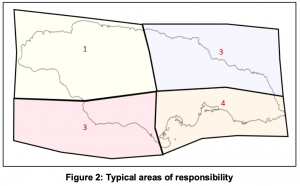
3.2. ATCOs would typically hold endorsements for several sectors within their area of responsibility and apart from combining and de-combining these sectors as demand changed, the boundaries of the sectors remained rigid (figure 2).
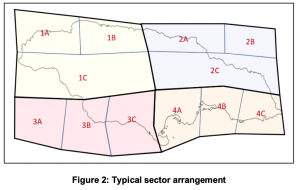
3.3. The geographical dimensions of sectors and route structures are typically determined by the historic traffic demand. Higher demand results in increased monitoring, conflict and coordination workload. Fixed sector boundaries and route structures mean controllers are not only proficient in the air traffic control ‘skills’ required to safely manage aircraft, they also use their ‘knowledge’ of the sector and route structures to identify and manage conflict ‘hotspots’ and traffic scenarios. ATCOs may typically hold an endorsement for several sectors and, apart from combining and de-combining these sectors as demand changes, the boundaries of the sectors remain rigid (figure 3).
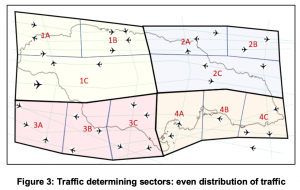
3.4. Other factors determining the boundaries of a sector include:
- State boundaries or bilateral agreements for provision of ATS;
- International agreements for provision of ATS over international waters;
- Location of areas of special use – danger, prohibited, temporary segregated; and
- Geographical characteristics of the area, type of service that is to be provided, radio and surveillance coverage.
3.5. However, traffic patterns change over time whether it be in an hour, day, week or season. This is sometimes referred to as ‘traffic volatility’. This means sector dimensions optimised for the demands of a busy morning may become sub-optimal in the evening. Of course, groups of sectors are routinely combined and de-combined to adapt to changes in traffic flows and demands.
3.6. However, ANSPs are responding to operators’ increasing demands for more optimised flight paths. Traditionally, route structures were designed to ensure traffic was ‘segregated’ as much as possible. The purpose of this so-called ‘strategic’ separation was to require less ‘tactical’ separation from the ATCO. However, this typically resulted in aircraft being cleared on a route that was not a straight line between departure and destination, adding fuel costs to the operators.
3.7. A rigid route structure also does not allow operators to plan based on current meteorological conditions and forecasts. For example, wind forecasts may mean that the segregated route is not the most efficient route. This can be significant for long haul flights trying to use or avoid jet streams.
3.8. Developments in avionics, particularly the near universal use of Global Navigation Satellite Systems (GNSS), means that aircraft are no longer constrained to routes defined by ground-based navigation aids. This has led to the concept of ‘user preferred routes’(UPRs). In Europe, ‘free route airspace’ (FRA) is a concept where within specified airspace users can freely plan a route between a defined entry point and exit point. User-preferred routing is not as suited to rigid sectors. Sectors can’t constrain routes when they are not defined. Conflict hotspots change dynamically.
3.9. ANSPs are increasingly looking for more ‘granularity’ when matching capacity with actual traffic flows and demand. The ability to easily change the airspace an ATCO is responsible for managing to more closely match capacity with demand at a given moment is known as ‘dynamic sectorisation’. In 2016 the Irish and English ANSPs successfully trialled cross-border dynamic sectorisation. Although the focus of the trial was the challenge of transferring control of sectors between ANSPs using different ATC systems, it was acknowledged that tactical management of sectors would inevitably depend on having ‘the right resources, training and sufficient notice’.
3.10. Dynamic sectorisation occurs where new ‘sectors’ are dynamically created to adapt to traffic demand. ATCOs are assigned to these newly formed sectors from areas where demand is less. As these sectors are dynamic, it may be the ATCO has never worked traffic in this area. Figure 4 illustrates how new sectors are created where demand is high (sectors 5A to 5F) and other sectors are combined where demand is low. Spare controllers are re-assigned to the new sectors even though they do not hold ‘unit endorsements’ for them.
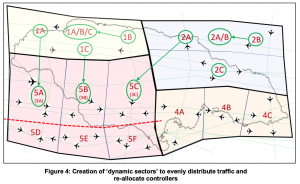
3.11. The focus of this paper is to examine the effect of dynamic sectorisation on the skillset and knowledge the ATCO will require to operate in this type of environment.
Unit Endorsement
4.1. The air traffic controller licensing structure as detailed in ICAO Annex 1 does not include a reference to endorsements (see 1.1). In Europe, Commission Regulation (EU) 2015/340 states the technical requirements and administrative procedures relating to air traffic controllers’ licences. The competence of an air traffic controller is demonstrated by the licence on which there should be a rating indicating the type of air traffic service they are competent to provide. The licence should also contain unit endorsements that reflect the particular sector(s) or working position(s) on which it’s exercised.
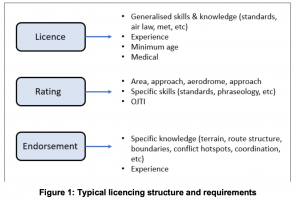
4.2. Although there are some variations, the licensing requirements in most States align with the European model. Therefore, for the purposes of this paper, when referring to licensing requirements generally, and in particular unit endorsements, it will be in the context of EU 2015/340.
4.3. As mentioned briefly at 1.1, the term ‘endorsement’ can refer to a number of different things (OJTI endorsement, language proficiency endorsement, assessor endorsement, etc). However, in the context of this paper, endorsement refers to ‘unit endorsement’ defined in EU 2015/340 as an ‘authorisation entered on and forming part of a licence, indicating the ICAO location indicator and the sector, group of sectors or working positions where the licence holder is competent to work’ (figure 1).
4.4. When applied to the concept of dynamic sectorisation, this definition of endorsement becomes problematic. Dynamic sectorisation may not necessarily result in the ATCO working on sectors (or group of sectors) in the same geographical location. Sector dimensions will be determined by the capacity required to meet the demand.
4.5. This definition of endorsement also raises issues with training and validation. ‘Validation’ is the process by which, through the successful completion of a unit endorsement course associated to a rating or a rating endorsement, the holder may start exercising the privileges of that rating or rating endorsement. Presently unit endorsement courses consist almost exclusively of the trainee acquiring the knowledge specific to sector(s) to which they have been assigned, including a period of on-the-job training (OJT). OJT helps the controller to consolidate this knowledge. Acquiring ‘sector specific’ knowledge becomes difficult when dimensions can change on a daily (or hourly) basis. Theoretically, a sector could encompass a geographic area the ATCO has never worked on before.
4.6. For this reason, the current concept of unit endorsements aligning with specific geographical locations, are not compatible with dynamic sectorisation. To address this, some ANSPs are proposing a new type of endorsement – performance-based endorsements.
Performance-based Endorsements
5.1. ‘Performance-based endorsement’ is the term being used to describe the type of endorsement that will support dynamic sectorisation. It is not a widely used term and currently is only used in Australia to describe the type of endorsement required to support dynamic sectorisation. Australia has not yet introduced dynamic sectorisation but it is in the process of acquiring a new ATC system that will offer it as a feature. As other ANSPs start using dynamic sectorisation another term might be more widely adopted but the concept is the same.
5.2. ICAO Doc 9868 – PANS-TRNG provides a high-level framework for competency-based training and identifies the required competency units and performance criteria. The framework can be elaborated upon at the local level depending on the rating the trainee is trying to achieve (aerodrome, approach, area, etc).
5.3. The knowledge and skills required to achieve a particular rating are also detailed in Annex 1. Of note is that a number of the ‘knowledge’ elements required are directly related to the airspace on which the rating will be achieved including air navigation facilities, terrain and prominent landmarks, airspace structure and characteristics. Usually, this ‘localised’ knowledge is covered in the unit training course designed for the ATCO to achieve an endorsement at a specific location or sector.
5.4. Of course, the general skill and knowledge requirements to achieve rating standard are still necessary and are detailed in Annex 1. These are complemented by the generic competency units and associated performance criteria in PANS-TRNG. But these must be distinguished from the localised knowledge requirements of a particular location of sector. This distinction will become increasingly important with the introduction of dynamic sectorisation because whilst the skills and knowledge required to do, for example, area control procedural, should remain relatively settled, the knowledge required to apply those skills to a particular piece of airspace will vary from location to location (figure 4).
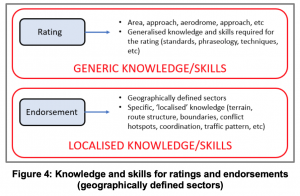
5.5. Although ICAO does not recognise unit endorsements, most State regulators have introduced them as a means to distinguish between the generic skills and knowledge a trainee must meet before being issued with an air traffic controller licence and rating, and the local knowledge a trainee will require to validate at a particular location or sector (or group of sectors). This distinction will become increasingly important with performance-based endorsements.
Licence, Rating and Endorsement Structure
6.1. By their nature, performance-based endorsements depend on the type of air traffic control service being performed rather the geographical location where it is being performed. In this way they are more closely aligned with air traffic controller ratings. In a dynamic sectorisation environment, an ATCO issued with an area control surveillance rating would be expected to perform an area control surveillance service in any airspace regardless of geographical location.
6.2. For most States, the skill and knowledge requirements for air traffic control licences and ratings will remain largely unchanged. They will still include subjects like rules and regulations, air traffic control equipment, general knowledge, operational procedures etc. Trainees will still need to acquire skills and knowledge particular to the rating to be achieved.
6.3. Ideally, air traffic control initial training should not include location specific knowledge. This training is left for the unit training course where candidates train for location or sector specific endorsements.
6.4. Thus, in a dynamic sectorisation environment, the skills and knowledge required to perform the generic ATC function (as determined by the rating) would be applied regardless of the location. Location specific knowledge required to validate is left to the unit training course. In the current environment, after successfully completing the unit training course and OJT requirements, a ‘sector specific’ endorsement is issued.
6.5. In a dynamic sectorisation environment, where sectors are not defined by geographic location, the ability for ATCOs to gain ‘localised’ knowledge is limited. Routes can change daily so conflict ‘hotspots’ and traffic patterns cannot be learned. Sector boundaries are constantly changing so coordination requirements are fluid (figure 5).
6.6. Localised knowledge is still essential to provide a safe and efficient air traffic control service. However, if the ATCO is no longer in a position to rely on this then the question becomes, ‘in a performance-based environment, what replaces the ATCOs ability to apply localised information to maintain a safe and efficient air traffic control service?’.
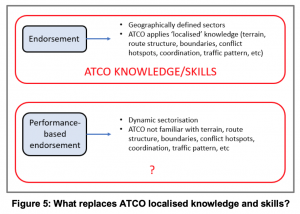
Requirements for Performance-based Endorsements
7.1. Endorsements have traditionally been linked to specific locations or sector(s) in fixed geographical locations for good reason. Location based knowledge is critical for controllers to provide a safe and efficient air traffic control service. Knowledge of local conditions such as conflict hotspots, frequencies, terrain, traffic flows, local aerodromes and airspace are examples of some of the local knowledge ATCOs routinely use. This knowledge is essential.
7.2. The requirement for this information does not change in a dynamic sectorisation environment. It is still just as important. However, it’s not reasonable for an ATCO to retain this knowledge for all the possible airspace configurations. In a dynamic sectorisation environment, an ATCO may be required to control airspace in a geographical area they have never worked before. The issue becomes, if the ATCO cannot be expected to learn and retain this location specific knowledge, where will the information come from and how will it be presented? The answer to this question is the key in determining whether or not dynamic sectorisation and performance-based endorsements can be safely implemented.
Automation and human-system integration
7.3. Like so many issues facing aviation, ATC system designers are relying on automation to address this issue. For each element of localised knowledge the ATCO will not longer have, the ATC system must provide a suitable alternative. For example, consider oceanic airspace above FL245. Currently, this airspace might be divided up into a number of sectors each with a defined route structure. Each sector has a separate endorsement and controllers may validate on one or several sectors. These sectors can be combined and de-combined as determined by traffic.
7.4. Amongst other location specific knowledge, controllers operating in this environment would be expected to be aware of conflict hotspots, frequency requirements and coordination requirements. However, in a dynamic sectorisation environment, the ATCO would not be expected to have this knowledge. In that case, the ATC system must provide an alternative.
7.5. So in this example, suitable conflict detection tools must substitute for controller knowledge of conflict hotspots. System tools must also provide suitable frequency and coordination transfer prompts to replace localised knowledge. These are examples where suitable alternatives to localised knowledge might support dynamic sectorisation and the associated performance- based endorsements. However, these are only simple examples. The complexity of airspace and traffic patterns will affect implementation.
7.6. The European ATM Master Plan acknowledges that automated support tools are fundamental to the successful introduction of the SESAR Target Concept. Although not specifically addressing performance-based endorsements and dynamic sectorisation, the principles are equally applicable. Although ANSPs are proposing operations that are only possible with the support of automation, it may not be the panacea that is hoped for.
7.7. Whilst automation may be suited to routine tasks, it does not adapt as well to non-nominal or degraded modes of operation including unexpected events. What happens when the system reaches a point where it can only be operated safety with the support of automation and then, because of an unexpected event, those support tools are no longer available.
7.8. Of increasing importance is the redistribution of authority between humans and the system – who is ultimately responsible for conflict detection, the system or the controller using system tools? What about if a system automatically detects and resolves conflicts? Who is responsible if it doesn’t work? The controller, the system monitor, the system programmer? Delegating safety critical functions to a system is an important area of development and one that could be worth of further investigation by PLC.
7.9. During the development phase of these automated support tools, it is critically important to involve operational aviation professions. Only people experienced in performing the tasks that the support tools are proposed to replace can ultimately ensure they are fit-for-purpose.
7.10. For example, with the involvement of ATCO, medium- and long-term automated conflict detection is already a feature of some air traffic control systems. It is largely successful because it’s utilised in oceanic airspace where there is less reliance on location specific information. However, in other operating environments it will be far more difficult to develop system tools that can substitute for localised knowledge.
7.11. An obvious example is in an aerodrome environment. By its very nature, an aerodrome controller requires far more location specific knowledge than an area procedural controller operating in oceanic airspace. For example, it is hard to imagine a system tool that could substitute for an aerodrome controller’s knowledge of a taxiway system or terrain. The only way that system designers will be able to assess whether or not the system tools will be fit-for-purpose will be through the input of those that currently hold endorsements in that airspace.
7.12. For this reason, performance-based endorsements may not be suited to all air traffic environments.
7.13. Summarising, the test for whether dynamic sectorisation and performance-based endorsements can be implemented will be whether suitable system tools can be developed that could remove the requirement for an ATCO to retain the localised skills and knowledge required to safely provide an air traffic control service.
Conclusion
8.1. Amongst other things, successful implementation of dynamic sectorisation and performance- based endorsements will consist of two steps:
-
- Identify the localised knowledge required to safety operate at a particular location or specific volume of airspace (a ‘sector’);
- Develop suitable system tools that can replace the requirement for the ATCO to retain that knowledge.
8.2. For the first step, a comprehensive ‘knowledge audit’ must be conducted to identify the knowledge required to safety operate in the location or airspace for which performance-based endorsements are being proposed. It is critical that ATCOs familiar with the location or airspace are involved in this process.
8.3. Equally for the second step, ATCOs familiar with the location or airspace must participate in the development of any system tools to replace the knowledge requirements. Ultimately, it is the ATCO that will be in the best position to judge whether the system tool is an adequate replacement for the localised knowledge.
References
Ehrmanntraut, R., & McMillan, S. (2007). Airspace Design Process for Dynamic Sectorisation. Paper presented at the 26th Digital Avionics System Conference (DASC), Dallas.
European ATM Master Plan, 2015 Edition <https://www.sesarju.eu/masterplan> at 4.7.2 (31 January 2019).
EU, 2015/340 Technical Requirements and Administrative Procedures relating to Air Traffic Controllers’ Licences (EU, February 2015).
Eurocontrol, Free route airspace (FRA) <https://www.eurocontrol.int/articles/free-route-airspace>.
ICAO, Annex 1 – Personnel Licensing (ICAO, Eleventh ed, July 2011).
ICAO, ‘ASIA/PACIFIC SEAMLESS ATM PLAN’ (2013) .
ICAO Doc 9868, PANS-Training, (ICAO, Second ed, 2016).
Skybrary, Sectorisation Skybrary <https://www.skybrary.aero/index.php/Sectorisation#Advanced_Concepts_.E2.80.93_Dynamic_Sectorisation>.
Trandac, H., Baptiste-Heudiasyc, P., & V, D. (2003). Optimized Sectorization of Airspace with Constraints. Paper presented at the ATM Seminar, Budapest Hungary.


